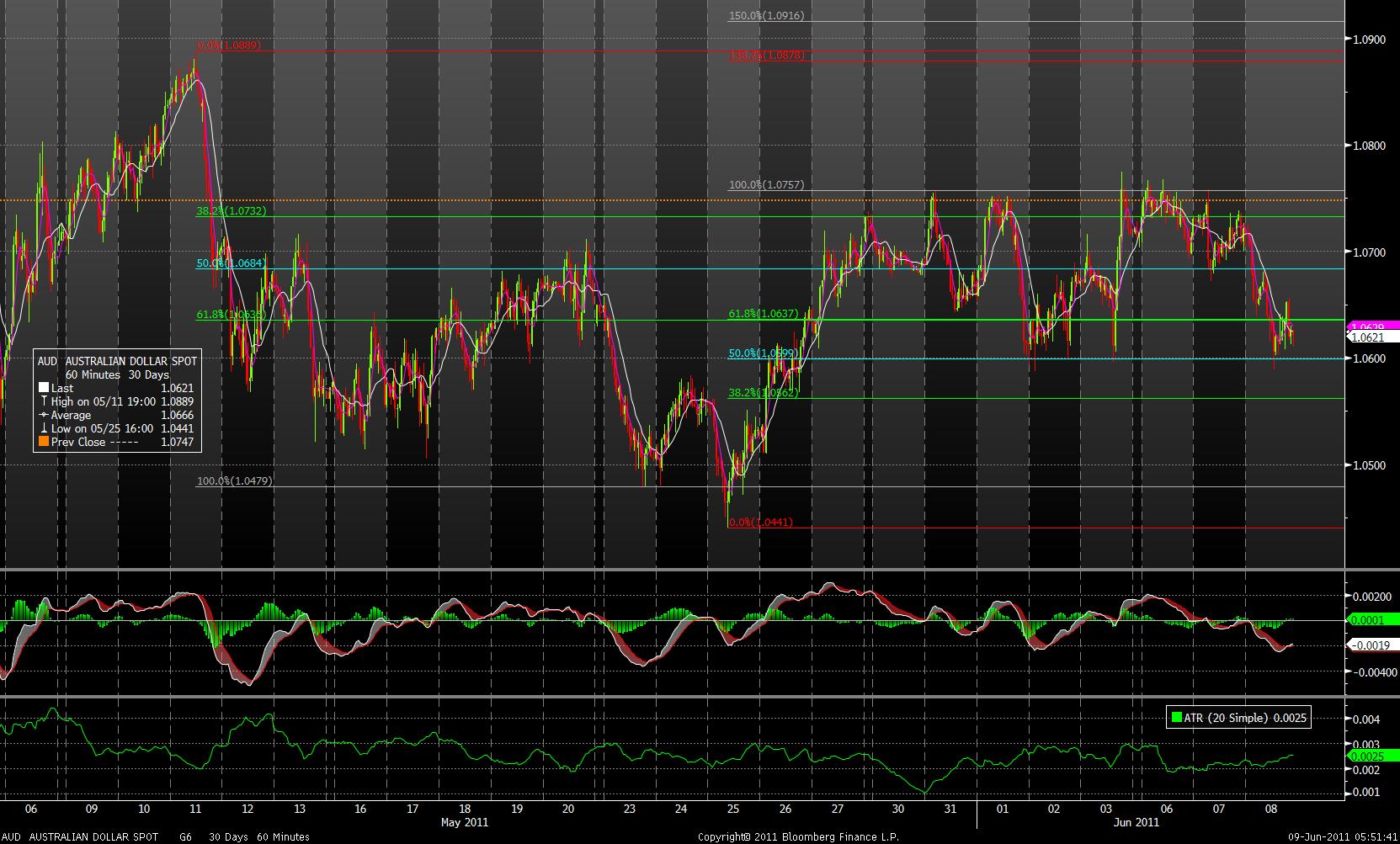Over the past 8 trading days the Aussie has essentially traded a 1.0590-1.0770 range as the competiting forces in currency land played out. Friday’s spike after non-farm payrolls on the back of the euro’s bounce has not been sustained and as I write the Aussie has bounced off the bottom of the range overnight and sits at at 1.0616.

To me it looks biased lower because of the weakness in equity markets and what this does to the outlook for other risky assets. It is important to note in the context about discussions of whether the Aussie has been re-rated and “new gold standard style talk” that my hypothesis is that the Aussie is still a “risky” asset but that its beta to moves in “risky” assets will be lower at present and unless or until either China or Australian housing pops it should outperform in a flight to safety but it will still be affected.
In his speech on Tuesday night US Fed Chairman Ben Bernanke said
…the decline in the dollar since February 2009 that I just noted followed a comparable increase in the dollar, which largely reflected flight-to-safety flows triggered by the financial crisis in the latter half of 2008; the dollar’s decline since then in substantial part reflects the reversal of those flows as the crisis eased.
I agree with that assessment but only up to a point, I think that the US has had a policy, whether benign neglect or active, of weakening its currency to try to get a free kick for exports. The market knows that.
But the interesting point in the context of the Aussie’s selling from the European open yesterday afternoon Asian time is the point he makes about flighth to saftey flows.
We are seeing a stealthy risk off move that is at risk of accelerating and I think Aussie longs might be lightening the load. With equity markets on the back foot at present, the Dow is down 6.61% since the end of April, the ASX 200 a more startling 9.51% and for me at least the bond market rally in the US (and elsewhere) is back in full swing with US 10 years having fallen from 3.66% at the end of April to 2.94% today.
So against this backdrop a rational trader would look to lighten the load of Aussie in their portfolio. Most likely to buy back lower, so support will still be there, but certainly to take advantage of the swing. Other traders in other currencies will be doing likewise and the USD is likely to find a little safe haven bid.
But its not just a sentiment thing either is it. We can’t ignore Bernanke’s implied support for the USD in his speech. At these low levels on the USD Index, or with the EUR having been up at 1.47 yesterday (1.4571) we are at the extreme end of the acceptable USD range. The reason I say this is that I believe policy makers and politicians know that global markets and economies cannot cope with a full scale USD rout with the present fingers of instability.
Bernanke did a fairly good, if misguided job of debunking the link between the USD’s fall and commodities rise:
…some have argued that accommodative U.S. monetary policy has driven down the foreign exchange value of the dollar, thereby boosting the dollar price of commodities. Indeed, since February 2009, the trade-weighted dollar has fallen by about 15 percent. However, since February 2009, oil prices have risen 160 percent and nonfuel commodity prices are up by about 80 percent, implying that the dollar’s decline can explain, at most, only a small part of the rise in oil and other commodity prices; indeed, commodity prices have risen dramatically when measured in terms of any of the world’s major currencies, not just the dollar.
But that kind of misses the point doesn’t it? And flies in the face of Janet Yellen’s (finally) admission last week that QE2 and the free money culture is all about targetting asset price appreciation. Minsky would be rolling in his grave, but in today’s money manager capitalistic market, commodities are assets just like shares in BHP. So they get pumped up too.
And so, with the Dollar Index heading toward the lows and the EUR headed back toward 1.50 and particulalry when the Yen is below 80 we are at risk of such a rout in the USD as to destabilise the global financial landscape. So for mine this is where the policy makers will start jawboning and twisting arms.
Also into this equation, we must ask if the apparent softening of the RBA’s outlook has impacted the Aussie. I’d say yes, but only at the margin. They still have a tightening bias, the global bond rally is still positive in a differential sense for the Aussie and the outlook for the Australian economy (in an offiical sense anyway) has not been downgraded. The upshot is that I don’t think the RBA has impacted materially.
So at the moment if the USD finds support again toward the lows as it did overnight and if it stops falling and if risk is a little off then the AUD looks biased to head back toward the lows of the past month or so around 1.0450.
I’ve thought that a few times in the last couple of weeks and been wrong and we always trade the range until it breaks but unless equities bounce a little I think the balance of probabilities is for the Aussie to test the downside.